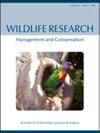我们是否需要挖掘社交媒体数据来检测外来脊椎动物害虫的引入?
IF 1.6
3区 生物学
Q3 ECOLOGY
引用次数: 3
摘要
本文章由计算机程序翻译,如有差异,请以英文原文为准。
Do we need to mine social media data to detect exotic vertebrate-pest introductions?
ABSTRACT Invasive alien species are responsible for considerable biodiversity loss and environmental damage. Timely detection of new incursions is critical in preventing novel populations establishing. Citizen reports currently account for the majority of alien species detections, arising from the massive observation effort that the physical and digital ‘eyes and ears’ of citizens provide, in combination with crowd-sourced species identification. Because the reporting of alien species sightings is generally not mandatory, there is interest in whether mining social media data via image recognition and/or natural language processing can improve on existing passive citizen surveillance in a cost-effective manner. Here, we illustrate, using examples from Australia, how citizen surveillance for most vertebrate groups appears to currently be effective using existing voluntary reporting mechanisms. Where citizen surveillance is currently ineffective, for reasons of inadequate sampling, data mining of social media feeds will be similarly affected. We argue that mining citizens’ social media data for evidence of invasive alien species needs to demonstrate not only that it will be an improvement on the business as usual case, but also that any gains achieved cannot be achieved by alternative approaches. We highlight the potential role of education in increasing the surveillance effectiveness of citizens for detecting and reporting sightings of alien species. Should data mining of social media platforms be pursued, we note that the scale of the task in terms of the potential number of exotic vertebrate species to be classified is very large. The expected number of false positive classifications would present a considerable workload to process, possibly undermining the efficiency rationale for the use of data mining. Hence, prioritisation is needed, and we illustrate how the number of species to be classified can be reduced considerably. If we are to deploy data mining and analysis of social media data to help with detecting introductions of invasive alien species, we need to conduct it in a manner where it adds value and is trusted.
求助全文
通过发布文献求助,成功后即可免费获取论文全文。
去求助
来源期刊

Wildlife Research
生物-动物学
CiteScore
4.30
自引率
15.80%
发文量
56
审稿时长
3 months
期刊介绍:
Wildlife Research represents an international forum for the publication of research and debate on the ecology, management and conservation of wild animals in natural and modified habitats. The journal combines basic research in wildlife ecology with advances in science-based management practice. Subject areas include: applied ecology; conservation biology; ecosystem management; management of over-abundant, pest and invasive species; global change and wildlife management; diseases and their impacts on wildlife populations; human dimensions of management and conservation; assessing management outcomes; and the implications of wildlife research for policy development. Readers can expect a range of papers covering well-structured field studies, manipulative experiments, and analytical and modelling studies. All articles aim to improve the practice of wildlife management and contribute conceptual advances to our knowledge and understanding of wildlife ecology.
Wildlife Research is a vital resource for wildlife scientists, students and managers, applied ecologists, conservation biologists, environmental consultants and NGOs and government policy advisors.
Wildlife Research is published with the endorsement of the Commonwealth Scientific and Industrial Research Organisation (CSIRO) and the Australian Academy of Science.
 求助内容:
求助内容: 应助结果提醒方式:
应助结果提醒方式:


